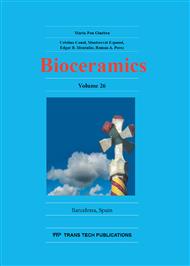[1]
V Lekovic, EB Kenney, M Weinlander, Han T, PR Klokkevold. A bone regenerative approach to alveolar ridge maintenance following tooth extraction. Report of 10 cases, J Periodontol 6 (1997) 563–570.
DOI: 10.1902/jop.1997.68.6.563
Google Scholar
[2]
JT Melloning. Guided tissue regeneration and endosseous dental implants, Int J Periodontics Restorative Dent 13 (1993) 109–119.
Google Scholar
[3]
J La Fontaine, et al. Regeneração Óssea Guiada. ImplantNews 5(4) (2008) 369-375.
Google Scholar
[4]
PJ Boyne, NR Sands. Combined orthodontici-surgical management of residual palato-alveolar cleft defect, Am J Orthod Dentofac Orthop 70 (1976) 20-37.
DOI: 10.1016/0002-9416(76)90258-x
Google Scholar
[5]
PJ Boyne, NR Sands,. Secondary bone grafting of residual alveolar and palatal defects,. J Oral Maxillofac Surg 30 (1972) 87-92.
Google Scholar
[6]
C. Dahlin, L. Andersson, A. Lindhe. Bone augmentation at fenestrated implants by osteopromotive membrane technique, A controlled clinical study. Clin Oral Implants Res 2(4) (1991) 159-165.
DOI: 10.1034/j.1600-0501.1991.020401.x
Google Scholar
[7]
P. S Rosen, M. A. Reynolds, and G. M. Bowers. The treatment of intrabony defects with bone grafts. Periodontology 2000 22. 1 (2000) 88-103.
DOI: 10.1034/j.1600-0757.2000.2220107.x
Google Scholar
[8]
M. D. Calasans-Maia, et al. Stimulatory Effect on Osseous Repair of Zinc-substituted Hydroxyapatite: Histological Study in Rabbit's Tibia. Key Engineering Materials. 361-363 (2008) 1269-1272.
DOI: 10.4028/www.scientific.net/kem.361-363.1269
Google Scholar
[9]
RZ. LeGeros. Properties of osteoconductive biomaterials: Calcium phosphates. Clin Orthop Relat Res 395 (2002) 81–98.
DOI: 10.1097/00003086-200202000-00009
Google Scholar
[10]
H Ohgushi, J Miyake, T Tateishi. Mesenchymal stem cells and bioceramics: strategies to regenerate the skeleton. Novartis Found Symp 249 (2003) 118–27.
DOI: 10.1002/0470867973.ch9
Google Scholar
[11]
S Sanchez-Salcedo, F Balas, I Izquierdo-Barba, M Vallet-Regi. In vitro structural changes in porous HA/beta-TCP scaffolds in simulated body fluid. Acta Biomater 5 (2009) 2738–51.
DOI: 10.1016/j.actbio.2009.03.025
Google Scholar
[12]
I. R de Lima, G. G. Alves, C. A Soriano, A. P. Campaneli, T. H. Gasparoto, , E. S. Ramos, L. A. de Sena, A. M Rossi and J. M. Granjeiro. Understanding the impact of divalent cation substitution on hydroxyapatite: an in vitro multiparametric study on biocompatibility, J Biomed Mater Res A 98 (2011).
DOI: 10.1002/jbm.a.33126
Google Scholar
[13]
E Landi, G Logroscino, L Proietti, A Tampieri, M Sandri, S Sprio. Biomimetic Mg-substituted hydroxyapatite: From synthesis to in vivo behavior, J Mater Sci Mater Med 19 (2008) 239–247.
DOI: 10.1007/s10856-006-0032-y
Google Scholar
[14]
GX Ni, WW Lu, KY Chiu, ZY Li, DY Fong, KD Luk. Strontium-containing hydroxyapatite (Sr-HA) bioactive cement for primary hipreplacement. An in vivo study, J Biomed Mater Res B Appl Biomater 77 (2006) 409–415.
DOI: 10.1002/jbm.b.30417
Google Scholar
[15]
GM Blake, MA Zivanovic, AJ McEwan, DM Ackery. Sr-89 therapy: Strontium kinetics in disseminated carcinoma of the prostate, Eur J Nucl Med 12(9) (1986) 447–54.
DOI: 10.1007/bf00254749
Google Scholar
[16]
E Canalis, M Hott, P Deloffre, Y Tsouderos, PJ Marie. The divalent strontium salt S12911 enhances bone cell replication and bone formation in vitro. Bone 1996; 18(6): 517–23.
DOI: 10.1016/8756-3282(96)00080-4
Google Scholar
[17]
E Shorr, AC Carter. The usefulness of strontium as an adjuvant to calcium in the remineralization of the skeleton in ma,. Bull Hosp Jt Dis Orthop Inst. 13 (1952) 59–66.
Google Scholar
[18]
A Barbara, P Delannoy, BG Denis, PJ Marie. Normal matrixmineralization induced by strontium ranelate in MC3T3–E1osteogenic cells. Metabolism, (2004).
DOI: 10.1016/j.metabol.2003.10.022
Google Scholar
[19]
E Bonnelye, A Chabadel, F Saltel, P Jurdic. Dual effect of strontium ranelate: stimulation of osteoblast differentiation and inhibition of osteoclast formation and resorption in vitro. Bone. 42 (2008) 129–38.
DOI: 10.1016/j.bone.2007.08.043
Google Scholar
[20]
PJ Meunier, C Roux, E Seeman, S Ortolani, JE Badurski, TD Spector, et al. The effects of strontium ranelate on the risk of vertebra fracture in women with postmenopausal osteoporosis. N Engl J Med. 350 (2004) 459–68.
DOI: 10.1056/nejmoa022436
Google Scholar
[21]
GX Ni, KY Chiu, WW Lu, Y Wang, YG Zhang, LB Hao, et al. Strontium-containing hydroxyapatite bioactive bone cement in revision hip arthroplasty, Biomaterials 27 (2006) 4348–55.
DOI: 10.1016/j.biomaterials.2006.03.048
Google Scholar
[22]
DM Chen, YF Fu, GZ Gu. Preparation and solubility of the solid solution of strontium substituted hydroxyapatite, Chin J Biomed Eng. 20 (2003) 278–82.
Google Scholar
[23]
GX Ni, WW Lu, KY Chiu, ZY Li, DY Fong, KD Luk. Strontium containing hydroxyapatite (Sr-HA) bioactive cement for primary hip replacement: an in vivo study. J Biomed Mater Res. 77B (2006) 409–15.
DOI: 10.1002/jbm.b.30417
Google Scholar
[24]
CT Wong, WW Lu, WK Chan, KMC Cheung, KDK Luk, DS Lu, ABM Rabie, LF Deng, JCY Leong. In vivo cancellous bone remodeling on a strontium-containing hydroxyapatite (Sr-HA) bioactive cement. J Biomed Mater Res. 68A (2004) 513–21.
DOI: 10.1002/jbm.a.20089
Google Scholar
[25]
C. P. G Machado, A. V. B Pintor. M. A. K. D. A Gress. A. M, Rossi,J. M Granjeiro & M. D. C Maia,. Evaluation of strontium containing hydroxyapatite as bone substitute in sheep's tibia. Innovations Implant Journal, 5 (2010) 9-14.
Google Scholar
[26]
International Organization for Standardization. ISO 10993-5: Biological evaluation of medical devices-Part 5: Tests for in vitro cytotoxicity (2009) ISO 10993-5: (2009).
DOI: 10.2345/9781570203558
Google Scholar


